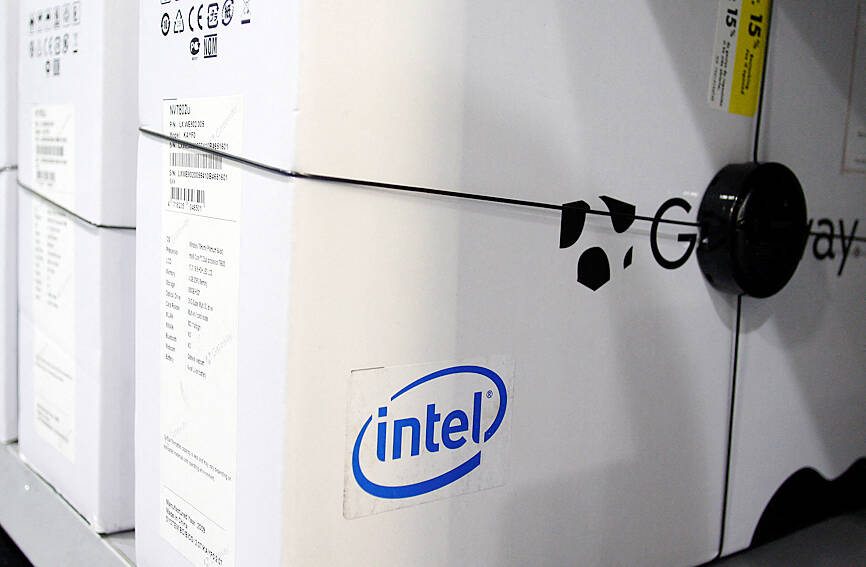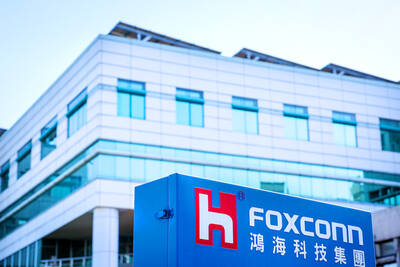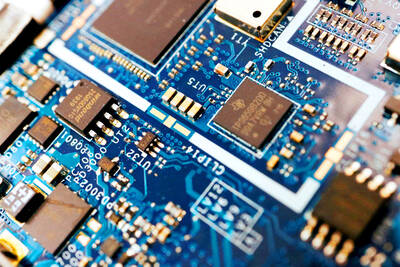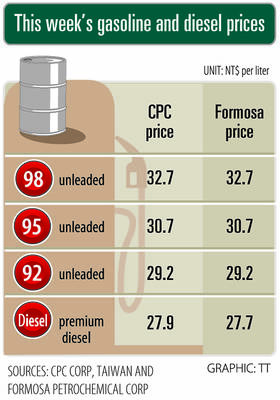Intel Corp shares jumped after the embattled chipmaker promised a recovery in the second half of this year, leading investors to look past a disappointing profit margin forecast for this quarter.
The company predicted that gross margin would begin to widen again in the second half.
Intel is returning to full manufacturing capacity, and an inventory glut afflicting the personal computer market is nearing an end, executives said on a conference call on Thursday.

Photo: REUTERS
The upbeat remarks helped send the shares up more than 6 percent in late trading after an earlier decline.
“You normally have a stronger second half in our industry, and we expect that to be the case,” Intel CEO Pat Gelsinger said on the call. “We’re seeing some green shoots in the marketplace, but we think it’s a tough market for all.”
The company also painted a more optimistic view of the broader PC industry, saying it expects shipments to reach 270 million units this year before increasing to about 300 million units annually. That would put the total back above the level last year, when shipments began sliding.
Gelsinger is confronting a massive pileup of inventory, weak demand and the loss of market share — all of which contributed to a historic slump. At the same time, he is trying to speed up the introduction of new production technology, a costly attempt to regain Intel’s industry leadership.
However, that effort — if successful — would not bear fruit until 2025. Investors have been skeptical that the chipmaker can catch up with rivals, and the stock plunged nearly 50 percent last year.
On Thursday, Gelsinger said that the company has begun to turn a corner.
“In the things that they can control, they’ve lived through the worst of that pain,” Benchmark Co analyst Cody Acree said.
In the near term, Intel’s financial outlook still looks dim. It expects losses per share of US$0.04 in the second quarter, excluding some items. That compares with an average estimate of losses per share of US$0.02 by analysts.
That initially sent shares down more than 2 percent in late trading, before a later rally.
They had closed at US$29.86, leaving them up 13 percent this year.
The revenue outlook was a bit brighter, with the company predicting sales of US$11.5 billion to US$12.5 billion. The midpoint of that range exceeds the average analyst estimate of US$11.7 billion.
Intel predicted that gross margin would be 37.5 percent in the second quarter. That compares with an estimate of 41 percent.
The company has been running its factories at below full capacity, meaning it has to take “underloading” charges that crimp margins.
While that headwind would recede as the company expects to increase output later this year, margins would not rebound to where they once were until those plants are upgraded, Intel chief financial officer Dave Zinsner said.
The factories need new manufacturing technologies that would be expensive to put in place.
Once that happens — and Intel is competitive with rivals again — the company hopes to restore profitability to historical levels.
When its factories were home to the industry’s most cutting-edge production, the company regularly posted a gross margin of more than 60 percent.
In the first quarter, Intel reported losses per share of US$0.04, excluding some items, better than the US$0.16 losses per share analysts had predicted.
Revenue was US$11.7 billion, beating analysts’ forecasts of US$11.1 billion, but sales have come down sharply in the pas few years. Intel had quarterly revenue of more than US$20 billion as recently as 2021.

Hon Hai Precision Industry Co (鴻海精密) yesterday said that its research institute has launched its first advanced artificial intelligence (AI) large language model (LLM) using traditional Chinese, with technology assistance from Nvidia Corp. Hon Hai, also known as Foxconn Technology Group (富士康科技集團), said the LLM, FoxBrain, is expected to improve its data analysis capabilities for smart manufacturing, and electric vehicle and smart city development. An LLM is a type of AI trained on vast amounts of text data and uses deep learning techniques, particularly neural networks, to process and generate language. They are essential for building and improving AI-powered servers. Nvidia provided assistance

GREAT SUCCESS: Republican Senator Todd Young expressed surprise at Trump’s comments and said he expects the administration to keep the program running US lawmakers who helped secure billions of dollars in subsidies for domestic semiconductor manufacturing rejected US President Donald Trump’s call to revoke the 2022 CHIPS and Science Act, signaling that any repeal effort in the US Congress would fall short. US Senate Minority Leader Chuck Schumer, who negotiated the law, on Wednesday said that Trump’s demand would fail, while a top Republican proponent, US Senator Todd Young, expressed surprise at the president’s comments and said he expects the administration to keep the program running. The CHIPS Act is “essential for America leading the world in tech, leading the world in AI [artificial

DOMESTIC SUPPLY: The probe comes as Donald Trump has called for the repeal of the US$52.7 billion CHIPS and Science Act, which the US Congress passed in 2022 The Office of the US Trade Representative is to hold a hearing tomorrow into older Chinese-made “legacy” semiconductors that could heap more US tariffs on chips from China that power everyday goods from cars to washing machines to telecoms equipment. The probe, which began during former US president Joe Biden’s tenure in December last year, aims to protect US and other semiconductor producers from China’s massive state-driven buildup of domestic chip supply. A 50 percent US tariff on Chinese semiconductors began on Jan. 1. Legacy chips use older manufacturing processes introduced more than a decade ago and are often far simpler than

Gasoline and diesel prices this week are to decrease NT$0.5 and NT$1 per liter respectively as international crude prices continued to fall last week, CPC Corp, Taiwan (CPC, 台灣中油) and Formosa Petrochemical Corp (台塑石化) said yesterday. Effective today, gasoline prices at CPC and Formosa stations are to decrease to NT$29.2, NT$30.7 and NT$32.7 per liter for 92, 95 and 98-octane unleaded gasoline respectively, while premium diesel is to cost NT$27.9 per liter at CPC stations and NT$27.7 at Formosa pumps, the companies said in separate statements. Global crude oil prices dropped last week after the eight OPEC+ members said they would